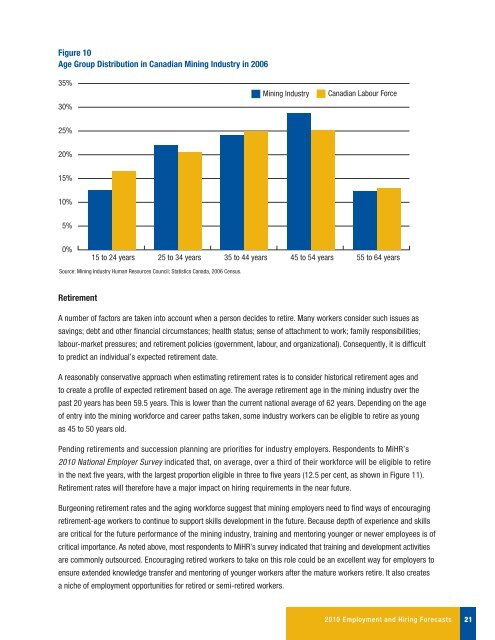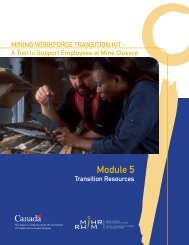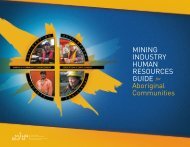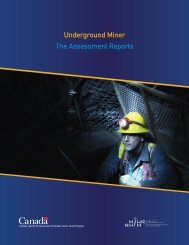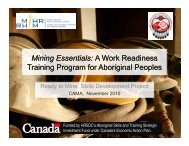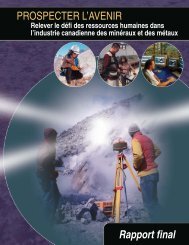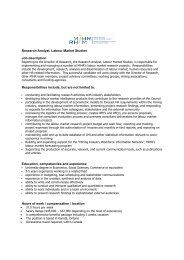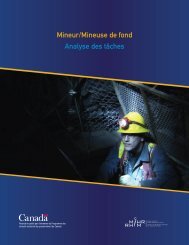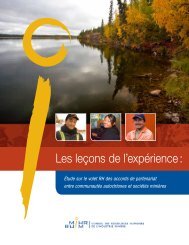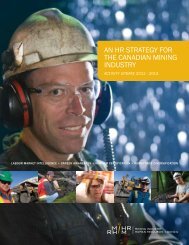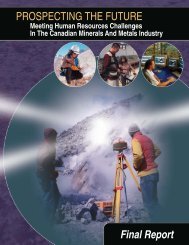Canadian Mining Industry Employment and Hiring Forecasts - MiHR
Canadian Mining Industry Employment and Hiring Forecasts - MiHR
Canadian Mining Industry Employment and Hiring Forecasts - MiHR
Create successful ePaper yourself
Turn your PDF publications into a flip-book with our unique Google optimized e-Paper software.
Figure 10<br />
Age Group Distribution in <strong>Canadian</strong> <strong>Mining</strong> <strong>Industry</strong> in 2006<br />
35%<br />
30%<br />
<strong>Mining</strong> <strong>Industry</strong><br />
<strong>Canadian</strong> Labour Force<br />
25%<br />
20%<br />
15%<br />
10%<br />
5%<br />
0%<br />
15 to 24 years<br />
25 to 34 years<br />
35 to 44 years<br />
45 to 54 years<br />
55 to 64 years<br />
Source: <strong>Mining</strong> <strong>Industry</strong> Human Resources Council; Statistics Canada, 2006 Census.<br />
Retirement<br />
A number of factors are taken into account when a person decides to retire. Many workers consider such issues as<br />
savings; debt <strong>and</strong> other financial circumstances; health status; sense of attachment to work; family responsibilities;<br />
labour-market pressures; <strong>and</strong> retirement policies (government, labour, <strong>and</strong> organizational). Consequently, it is difficult<br />
to predict an individual’s expected retirement date.<br />
A reasonably conservative approach when estimating retirement rates is to consider historical retirement ages <strong>and</strong><br />
to create a profile of expected retirement based on age. The average retirement age in the mining industry over the<br />
past 20 years has been 59.5 years. This is lower than the current national average of 62 years. Depending on the age<br />
of entry into the mining workforce <strong>and</strong> career paths taken, some industry workers can be eligible to retire as young<br />
as 45 to 50 years old.<br />
Pending retirements <strong>and</strong> succession planning are priorities for industry employers. Respondents to <strong>MiHR</strong>’s<br />
2010 National Employer Survey indicated that, on average, over a third of their workforce will be eligible to retire<br />
in the next five years, with the largest proportion eligible in three to five years (12.5 per cent, as shown in Figure 11).<br />
Retirement rates will therefore have a major impact on hiring requirements in the near future.<br />
Burgeoning retirement rates <strong>and</strong> the aging workforce suggest that mining employers need to find ways of encouraging<br />
retirement-age workers to continue to support skills development in the future. Because depth of experience <strong>and</strong> skills<br />
are critical for the future performance of the mining industry, training <strong>and</strong> mentoring younger or newer employees is of<br />
critical importance. As noted above, most respondents to <strong>MiHR</strong>’s survey indicated that training <strong>and</strong> development activities<br />
are commonly outsourced. Encouraging retired workers to take on this role could be an excellent way for employers to<br />
ensure extended knowledge transfer <strong>and</strong> mentoring of younger workers after the mature workers retire. It also creates<br />
a niche of employment opportunities for retired or semi-retired workers.<br />
2010 <strong>Employment</strong> <strong>and</strong> <strong>Hiring</strong> <strong>Forecasts</strong><br />
21


